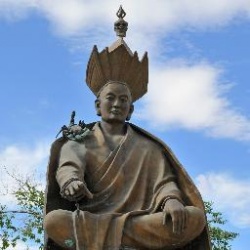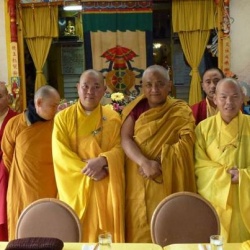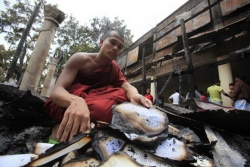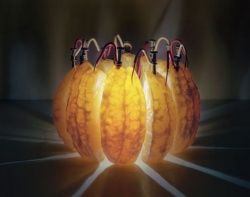Bardo Mandala
Also known as the "Mandala of the Peaceful and Wrathful Deities", this painting depicts all of the 100 fierce and gentle deities appearing in the bardo.
Interestingly, though rarely commented upon, 66 of the 100 deities are female.
Many of the ancient Tibetan teachings concerning this state between death and rebirth, have been written down in the Bardo Thödol, popularly known as Tibetan Book of the Dead.
This 8th century text, to be read aloud to the dying (respectively dead) person, is meant to guide her or him through the inner visions occurring during this phase of transition; a process that lasts twelve of the forty-nine days spent in bardo.
In these illuminated visions of spiritual reality, one encounters both gentle (or peaceful) and fierce (or wrathful) aspects of divinity - and thus of oneself.
According to the text, the number of deities thus encountered number one hundred; fifty-eight of which are of a fierce countenance and forty-two of a gentle one.
To aid people in comprehending these visions and to be prepared for them when they occur, artists have sometimes laid them out in one single mandala that depicts all one hundred deities with their numerous symbols and associations.
One such Thangka of the Fierce and Gentle Deities is shown above.
Although one does find variations among these paintings, depending on their origin (different Buddhist orders sometimes follow slightly different texts), the thangka described below is very typical and fits most of the available translations of the Bardo Thödol.
The visions, and the mandala, unfold themselves in the following order:
1st day
First to appear, nude and in inseparable union (yab-yum) is the divine couple formed by Samantabhadri (the Great Mother who produces all Buddhas of the three ages) and Samantabhadra (the Primordial Adibuddha).
Together, the white Samantabhadri (refined and discerning wisdom) and the blue Samantabhadra (non-discriminating universal awareness) embody the most exalted principle of Tibetan Tantra; the union of skillful means and profound cognition, also known as the union of path and goal.
The union of these two deities who represent the very highest realm, then gives rise to all subsequent 98 deities of the visions; each of whom is a specific projection of the human ego/mind.
First of these to appear, on this very day, is the divine couple formed by Akasha Dhatvishvari (one of the Wisdom Dakinis) and Vairocana (one of the Sambhogakaya Buddhas). They too, are seen to be in deep union (yab-yum).
2nd to 5th days
During each of these four days, another divine couple appears on each successive day. Each of these consists of one of the five Wisdom Dakinis in union with one the five Sambhogakaya Buddhas.
Each of these couples (in yab-yum) is attended (and surrounded) by two of the eight Bodhisattva Dakinis and two corresponding male Bodhisattvas, so that each day six deities appear in the visionary mandala.
6th day
On this day, fourteen further deities appear on the virtual inner stage of one's mind. These are the four Guardian Dakinis and the four corresponding fierce male guardians of the gates.
They are located outside the five couples that appeared earlier. Next, the six Buddhas of the Realms (gods, humans, hell etc.) make their appearance, closing the sequence of the forty-two gentle and peaceful deities.
7th day
As a transition between the host of 42 gentle deities, and the 58 fierce ones to appear from the 8th day onward, this day brings forth a mandala consisting of the five Dakini/Vidyadhara couples surrounded by a countless crowd of dakinis and protectors neither mild nor fierce of countenance.
All these do not count among the one-hundred major deities of the mandala.
8th to 12th days
The pattern of day 8 and the following days 9 to 12 follows that of the first 5 days described above. On each successive day, one couple appears; though this time around they each consist of a Krodeshvari emanation and a corresponding male Heruka.
12th day
When the last of the Krodeshvari/Heruka couples has manifested, there appear - surrounding them - the eight Kerima, goddesses also known as Gauri.
Next in line appear the eight Phramenma or Pisaci, fierce aspects of the Boddhisattva Dakinis (2nd-5th days). Once more, as on the 6th day, four female guardians appear, this time heralding the arrival of the final twenty-eight deities, the fierce & powerful flesh-eating yoginis.



